Criminology and Criminal Justice: Force Factors and Recent Events
VerifiedAdded on 2022/08/26
|5
|1211
|17
Essay
AI Summary
This essay delves into the use of force by law enforcement in Canada, focusing on the legal framework and operational guidelines that govern police actions. It examines the force model, emphasizing the principle of proportionate response to perceived threats. The essay analyzes a recent incident in Montreal involving a police officer and a young black man, critically assessing the use of force employed. It argues that the force used was excessive and unnecessary, suggesting alternative strategies such as verbal de-escalation to alter the outcome. Furthermore, the essay explores the importance of minimizing the use of force and the duty of police officers to maintain peace and security. The conclusion highlights the dynamic nature of these situations and the significance of post-incident analysis.
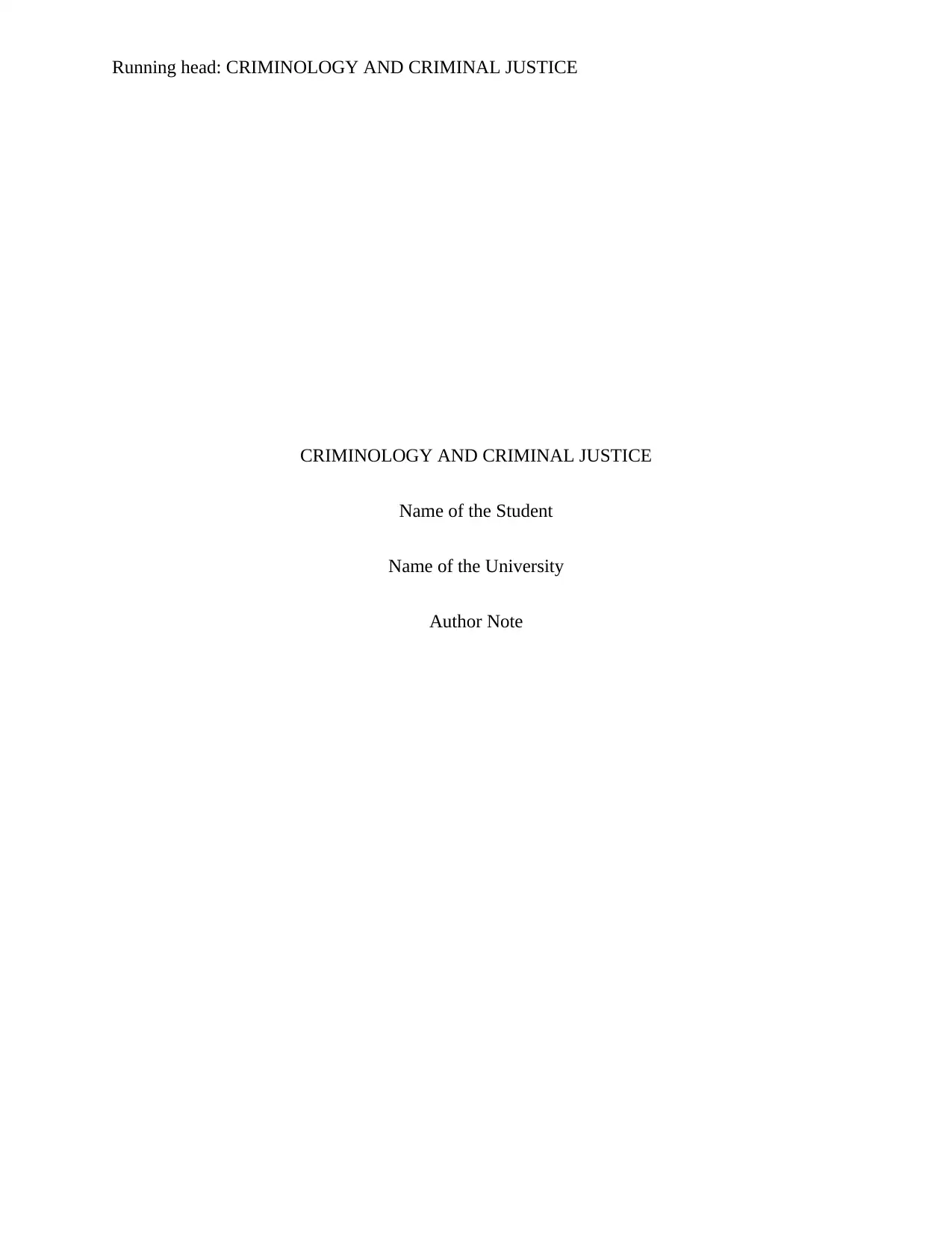
Running head: CRIMINOLOGY AND CRIMINAL JUSTICE
CRIMINOLOGY AND CRIMINAL JUSTICE
Name of the Student
Name of the University
Author Note
CRIMINOLOGY AND CRIMINAL JUSTICE
Name of the Student
Name of the University
Author Note
Paraphrase This Document
Need a fresh take? Get an instant paraphrase of this document with our AI Paraphraser
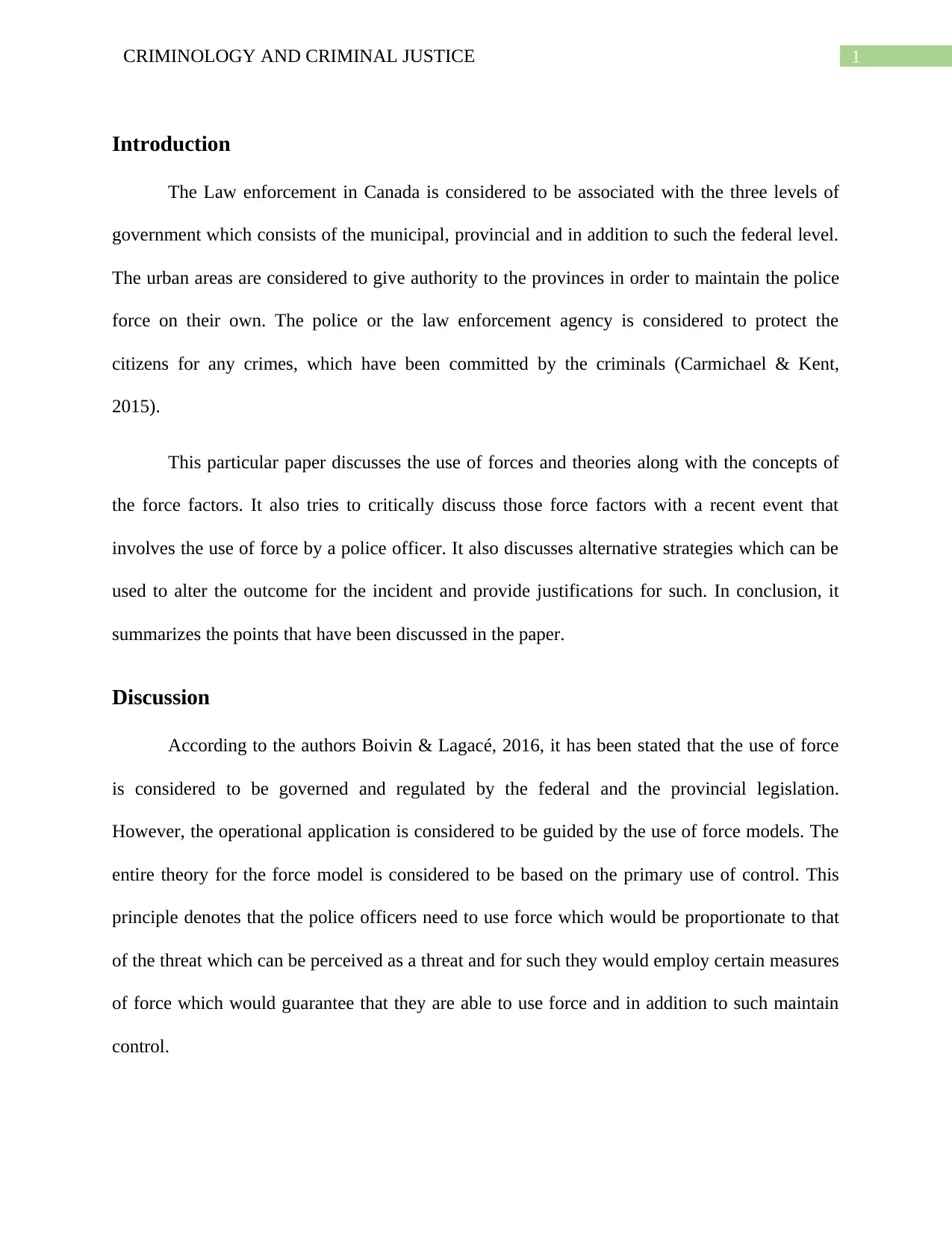
1CRIMINOLOGY AND CRIMINAL JUSTICE
Introduction
The Law enforcement in Canada is considered to be associated with the three levels of
government which consists of the municipal, provincial and in addition to such the federal level.
The urban areas are considered to give authority to the provinces in order to maintain the police
force on their own. The police or the law enforcement agency is considered to protect the
citizens for any crimes, which have been committed by the criminals (Carmichael & Kent,
2015).
This particular paper discusses the use of forces and theories along with the concepts of
the force factors. It also tries to critically discuss those force factors with a recent event that
involves the use of force by a police officer. It also discusses alternative strategies which can be
used to alter the outcome for the incident and provide justifications for such. In conclusion, it
summarizes the points that have been discussed in the paper.
Discussion
According to the authors Boivin & Lagacé, 2016, it has been stated that the use of force
is considered to be governed and regulated by the federal and the provincial legislation.
However, the operational application is considered to be guided by the use of force models. The
entire theory for the force model is considered to be based on the primary use of control. This
principle denotes that the police officers need to use force which would be proportionate to that
of the threat which can be perceived as a threat and for such they would employ certain measures
of force which would guarantee that they are able to use force and in addition to such maintain
control.
Introduction
The Law enforcement in Canada is considered to be associated with the three levels of
government which consists of the municipal, provincial and in addition to such the federal level.
The urban areas are considered to give authority to the provinces in order to maintain the police
force on their own. The police or the law enforcement agency is considered to protect the
citizens for any crimes, which have been committed by the criminals (Carmichael & Kent,
2015).
This particular paper discusses the use of forces and theories along with the concepts of
the force factors. It also tries to critically discuss those force factors with a recent event that
involves the use of force by a police officer. It also discusses alternative strategies which can be
used to alter the outcome for the incident and provide justifications for such. In conclusion, it
summarizes the points that have been discussed in the paper.
Discussion
According to the authors Boivin & Lagacé, 2016, it has been stated that the use of force
is considered to be governed and regulated by the federal and the provincial legislation.
However, the operational application is considered to be guided by the use of force models. The
entire theory for the force model is considered to be based on the primary use of control. This
principle denotes that the police officers need to use force which would be proportionate to that
of the threat which can be perceived as a threat and for such they would employ certain measures
of force which would guarantee that they are able to use force and in addition to such maintain
control.
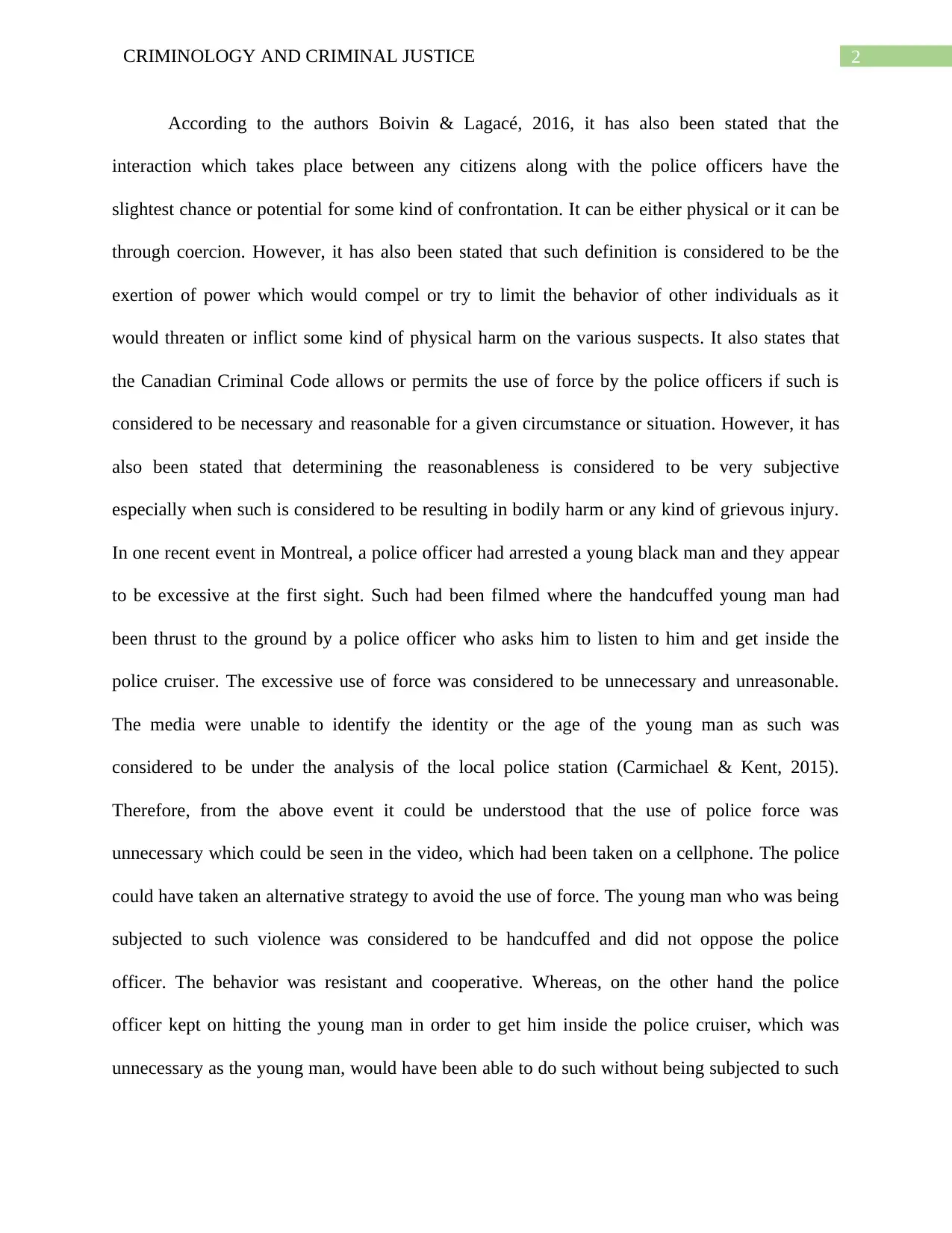
2CRIMINOLOGY AND CRIMINAL JUSTICE
According to the authors Boivin & Lagacé, 2016, it has also been stated that the
interaction which takes place between any citizens along with the police officers have the
slightest chance or potential for some kind of confrontation. It can be either physical or it can be
through coercion. However, it has also been stated that such definition is considered to be the
exertion of power which would compel or try to limit the behavior of other individuals as it
would threaten or inflict some kind of physical harm on the various suspects. It also states that
the Canadian Criminal Code allows or permits the use of force by the police officers if such is
considered to be necessary and reasonable for a given circumstance or situation. However, it has
also been stated that determining the reasonableness is considered to be very subjective
especially when such is considered to be resulting in bodily harm or any kind of grievous injury.
In one recent event in Montreal, a police officer had arrested a young black man and they appear
to be excessive at the first sight. Such had been filmed where the handcuffed young man had
been thrust to the ground by a police officer who asks him to listen to him and get inside the
police cruiser. The excessive use of force was considered to be unnecessary and unreasonable.
The media were unable to identify the identity or the age of the young man as such was
considered to be under the analysis of the local police station (Carmichael & Kent, 2015).
Therefore, from the above event it could be understood that the use of police force was
unnecessary which could be seen in the video, which had been taken on a cellphone. The police
could have taken an alternative strategy to avoid the use of force. The young man who was being
subjected to such violence was considered to be handcuffed and did not oppose the police
officer. The behavior was resistant and cooperative. Whereas, on the other hand the police
officer kept on hitting the young man in order to get him inside the police cruiser, which was
unnecessary as the young man, would have been able to do such without being subjected to such
According to the authors Boivin & Lagacé, 2016, it has also been stated that the
interaction which takes place between any citizens along with the police officers have the
slightest chance or potential for some kind of confrontation. It can be either physical or it can be
through coercion. However, it has also been stated that such definition is considered to be the
exertion of power which would compel or try to limit the behavior of other individuals as it
would threaten or inflict some kind of physical harm on the various suspects. It also states that
the Canadian Criminal Code allows or permits the use of force by the police officers if such is
considered to be necessary and reasonable for a given circumstance or situation. However, it has
also been stated that determining the reasonableness is considered to be very subjective
especially when such is considered to be resulting in bodily harm or any kind of grievous injury.
In one recent event in Montreal, a police officer had arrested a young black man and they appear
to be excessive at the first sight. Such had been filmed where the handcuffed young man had
been thrust to the ground by a police officer who asks him to listen to him and get inside the
police cruiser. The excessive use of force was considered to be unnecessary and unreasonable.
The media were unable to identify the identity or the age of the young man as such was
considered to be under the analysis of the local police station (Carmichael & Kent, 2015).
Therefore, from the above event it could be understood that the use of police force was
unnecessary which could be seen in the video, which had been taken on a cellphone. The police
could have taken an alternative strategy to avoid the use of force. The young man who was being
subjected to such violence was considered to be handcuffed and did not oppose the police
officer. The behavior was resistant and cooperative. Whereas, on the other hand the police
officer kept on hitting the young man in order to get him inside the police cruiser, which was
unnecessary as the young man, would have been able to do such without being subjected to such
⊘ This is a preview!⊘
Do you want full access?
Subscribe today to unlock all pages.

Trusted by 1+ million students worldwide
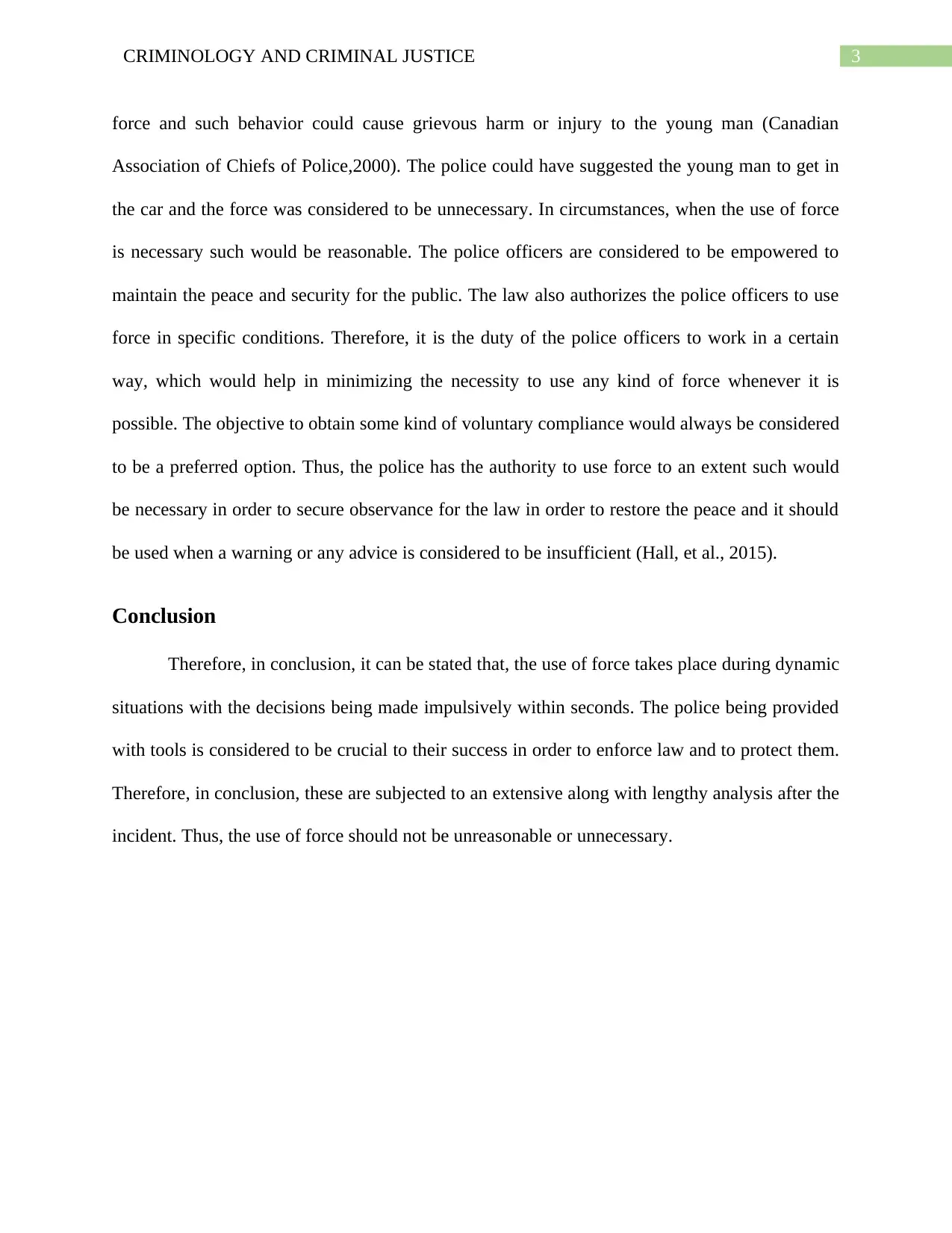
3CRIMINOLOGY AND CRIMINAL JUSTICE
force and such behavior could cause grievous harm or injury to the young man (Canadian
Association of Chiefs of Police,2000). The police could have suggested the young man to get in
the car and the force was considered to be unnecessary. In circumstances, when the use of force
is necessary such would be reasonable. The police officers are considered to be empowered to
maintain the peace and security for the public. The law also authorizes the police officers to use
force in specific conditions. Therefore, it is the duty of the police officers to work in a certain
way, which would help in minimizing the necessity to use any kind of force whenever it is
possible. The objective to obtain some kind of voluntary compliance would always be considered
to be a preferred option. Thus, the police has the authority to use force to an extent such would
be necessary in order to secure observance for the law in order to restore the peace and it should
be used when a warning or any advice is considered to be insufficient (Hall, et al., 2015).
Conclusion
Therefore, in conclusion, it can be stated that, the use of force takes place during dynamic
situations with the decisions being made impulsively within seconds. The police being provided
with tools is considered to be crucial to their success in order to enforce law and to protect them.
Therefore, in conclusion, these are subjected to an extensive along with lengthy analysis after the
incident. Thus, the use of force should not be unreasonable or unnecessary.
force and such behavior could cause grievous harm or injury to the young man (Canadian
Association of Chiefs of Police,2000). The police could have suggested the young man to get in
the car and the force was considered to be unnecessary. In circumstances, when the use of force
is necessary such would be reasonable. The police officers are considered to be empowered to
maintain the peace and security for the public. The law also authorizes the police officers to use
force in specific conditions. Therefore, it is the duty of the police officers to work in a certain
way, which would help in minimizing the necessity to use any kind of force whenever it is
possible. The objective to obtain some kind of voluntary compliance would always be considered
to be a preferred option. Thus, the police has the authority to use force to an extent such would
be necessary in order to secure observance for the law in order to restore the peace and it should
be used when a warning or any advice is considered to be insufficient (Hall, et al., 2015).
Conclusion
Therefore, in conclusion, it can be stated that, the use of force takes place during dynamic
situations with the decisions being made impulsively within seconds. The police being provided
with tools is considered to be crucial to their success in order to enforce law and to protect them.
Therefore, in conclusion, these are subjected to an extensive along with lengthy analysis after the
incident. Thus, the use of force should not be unreasonable or unnecessary.
Paraphrase This Document
Need a fresh take? Get an instant paraphrase of this document with our AI Paraphraser
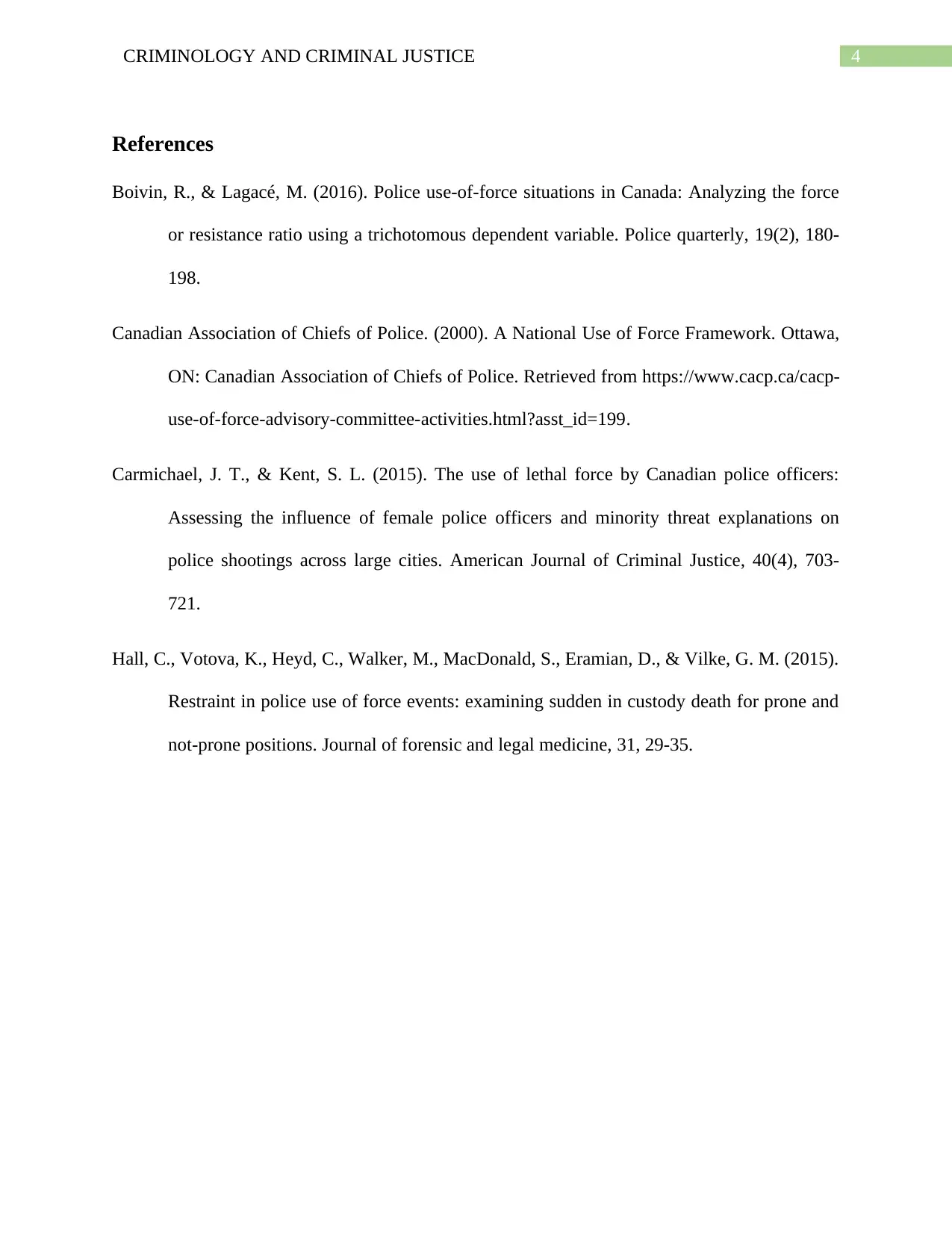
4CRIMINOLOGY AND CRIMINAL JUSTICE
References
Boivin, R., & Lagacé, M. (2016). Police use-of-force situations in Canada: Analyzing the force
or resistance ratio using a trichotomous dependent variable. Police quarterly, 19(2), 180-
198.
Canadian Association of Chiefs of Police. (2000). A National Use of Force Framework. Ottawa,
ON: Canadian Association of Chiefs of Police. Retrieved from https://www.cacp.ca/cacp-
use-of-force-advisory-committee-activities.html?asst_id=199.
Carmichael, J. T., & Kent, S. L. (2015). The use of lethal force by Canadian police officers:
Assessing the influence of female police officers and minority threat explanations on
police shootings across large cities. American Journal of Criminal Justice, 40(4), 703-
721.
Hall, C., Votova, K., Heyd, C., Walker, M., MacDonald, S., Eramian, D., & Vilke, G. M. (2015).
Restraint in police use of force events: examining sudden in custody death for prone and
not-prone positions. Journal of forensic and legal medicine, 31, 29-35.
References
Boivin, R., & Lagacé, M. (2016). Police use-of-force situations in Canada: Analyzing the force
or resistance ratio using a trichotomous dependent variable. Police quarterly, 19(2), 180-
198.
Canadian Association of Chiefs of Police. (2000). A National Use of Force Framework. Ottawa,
ON: Canadian Association of Chiefs of Police. Retrieved from https://www.cacp.ca/cacp-
use-of-force-advisory-committee-activities.html?asst_id=199.
Carmichael, J. T., & Kent, S. L. (2015). The use of lethal force by Canadian police officers:
Assessing the influence of female police officers and minority threat explanations on
police shootings across large cities. American Journal of Criminal Justice, 40(4), 703-
721.
Hall, C., Votova, K., Heyd, C., Walker, M., MacDonald, S., Eramian, D., & Vilke, G. M. (2015).
Restraint in police use of force events: examining sudden in custody death for prone and
not-prone positions. Journal of forensic and legal medicine, 31, 29-35.
1 out of 5
Related Documents
Your All-in-One AI-Powered Toolkit for Academic Success.
+13062052269
info@desklib.com
Available 24*7 on WhatsApp / Email
![[object Object]](/_next/static/media/star-bottom.7253800d.svg)
Unlock your academic potential
Copyright © 2020–2025 A2Z Services. All Rights Reserved. Developed and managed by ZUCOL.





